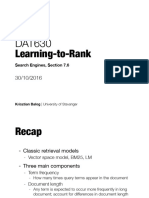Audio Media
Audio Media
Uploaded by
Keannu EstoconingCopyright:
Available Formats
Audio Media
Audio Media
Uploaded by
Keannu EstoconingOriginal Title
Copyright
Available Formats
Share this document
Did you find this document useful?
Is this content inappropriate?
Copyright:
Available Formats
Audio Media
Audio Media
Uploaded by
Keannu EstoconingCopyright:
Available Formats
AUDIO MEDIA
OBJECTIVES
Identify the different Audio Media and give their uses in facilitating the teaching-
learning process.
Be able to discuss their strengths and weaknesses.
Audio media
- are materials or sounds that are transmitted, produced or received thru high fidelity
waves which are heard thru certain equipment’s.
LUCIDO 1997
“The audio media are inexpensive materials; easy to use but can present stimulating verbal
messages more dramatically that the print media”.
KINDS OF AUDIO MEDIA
1. Radio Broadcast/Taped (Canned) Programs
- Radio Broadcast refers to the simultaneous transmission of messages to multiple
recipients through airwaves to a wide audience. It can be done live or taped.
- Meanwhile, taped or canned programs are pre-recorded content that is edited
before being broadcasted. It is an inexpensive means of reaching a mass audience
or a great number of learners.
2. Recordings
- Audio recording is the process by which sound information is captured onto a
storage medium like magnetic tape, optical disc, or solid-state drive (SSD) for
recording purposes.
Examples of Audio media
1. Music - vocal or instrumental sounds combined in such a way as to
produce beauty of form, harmony, and expression of emotion.
2. Sound recording - recording of an interview, meeting, or any sound from
the environment.
3. Sound clips/Effects - any sound artificially reproduced to create an effect in a
dramatic presentation (ex. sound of a storm, or a door)
4. Audio Podcast - a digital audio or video file or recording, usually part of a
themed series, that can be downloaded from a website to a media player or a
computer.
Advantages & Disadvantages
Advantages
1. Improves listening skills.
2. Enhances pronunciation and vocabulary.
3. Makes learning portable.
4. Supports visually impaired learners.
5. Encourages independent learning.
Disadvantages
1. Hard to revise or rewind.
2. Limited sensory engagement.
3. Not suitable for deaf students.
4. Requires good listening skills.
5. Can’t display visual information.
USES OF AUDIO MEDIA
Used for individualize instruction where the students can move at their own rates so as to
develop mastery.
They can play back the material until they fully understand and learn the lesson.
Can also be used to document speeches for analysis, to record interviews of resource
person, or to report findings of researches.
It is effective in story telling especially if pictures accompany them.
Good for stimulating listener's imagination.
Can be used to improved listening skills.
It is ideal for teaching foreign language.
Useful for those who have reading disabilities or non- readers.
You might also like
- 8.3 Organizational Climate QuestionnaireDocument3 pages8.3 Organizational Climate QuestionnaireOdion AkhaineNo ratings yet
- 2019-2020 Annual ReportDocument5 pages2019-2020 Annual ReportHuakailani School for GirlsNo ratings yet
- Chuka University MugendiDocument17 pagesChuka University MugendiAnonymous hosZihVD100% (2)
- Audio Information Media Hand OutDocument2 pagesAudio Information Media Hand OutClaire AliNo ratings yet
- MIL Q2 Module4 EditedDocument14 pagesMIL Q2 Module4 EditedAljun MisaNo ratings yet
- Audio Information and MediaDocument17 pagesAudio Information and Medianicole ann salvanNo ratings yet
- Audioinformationandmedia 230413130400 481d9527Document29 pagesAudioinformationandmedia 230413130400 481d9527cicidy28No ratings yet
- LP 8 AUDIO MediaDocument4 pagesLP 8 AUDIO Mediastephanie maloloyonNo ratings yet
- Topic/Lesson Name Content Standards Performance Standards Learning CompetenciesDocument5 pagesTopic/Lesson Name Content Standards Performance Standards Learning Competenciesrhiantics_kram11No ratings yet
- SounddesignDocument6 pagesSounddesignAlfie Lumpay CagampangNo ratings yet
- Date Topic Activities or Tasks: Week 6 - Audio Information and MediaDocument5 pagesDate Topic Activities or Tasks: Week 6 - Audio Information and MediaDharyn KhaiNo ratings yet
- Q2 Module 9 - Grade 12Document4 pagesQ2 Module 9 - Grade 12Jenold ParaisoNo ratings yet
- Audio Information and Media: Lesson 3Document7 pagesAudio Information and Media: Lesson 3Cecille HernandoNo ratings yet
- Audio Information and MediaDocument4 pagesAudio Information and MediaEbb Tenebroso JudillaNo ratings yet
- g12 Mil q2 Wk5 Audio MediaDocument7 pagesg12 Mil q2 Wk5 Audio MediaMJ NatividadNo ratings yet
- Audio Aids in Nursing EducationDocument37 pagesAudio Aids in Nursing EducationArjumand ZargarNo ratings yet
- Audio Information and MediaDocument2 pagesAudio Information and MediaLovely PateteNo ratings yet
- Media and Information Literacy: Quarter 2 - Module 11 & 12 Week 6Document11 pagesMedia and Information Literacy: Quarter 2 - Module 11 & 12 Week 6Louie RamosNo ratings yet
- AUDIO AND MOTION INFORMATION AND MEDIA (Lesson)Document6 pagesAUDIO AND MOTION INFORMATION AND MEDIA (Lesson)Vincent AcapenNo ratings yet
- Audio Information and MediaDocument2 pagesAudio Information and MediaDexter CaroNo ratings yet
- LESSON 13. Audio InformationDocument1 pageLESSON 13. Audio InformationLady Adelyn Castillo PontanosNo ratings yet
- Media and Information LiteracyDocument5 pagesMedia and Information LiteracyJea Marie MendozaNo ratings yet
- Group 7: Audio Information and MediaDocument3 pagesGroup 7: Audio Information and MediaNanette MangloNo ratings yet
- Audio Information and Media Motion Information and MediaDocument19 pagesAudio Information and Media Motion Information and MediaMoana HagnayaNo ratings yet
- Revised - Open and Distance Learning Material - Note PDFDocument9 pagesRevised - Open and Distance Learning Material - Note PDFRiya BanerjeeNo ratings yet
- Topic 7 Audio Edtech 1Document9 pagesTopic 7 Audio Edtech 1Nicole ApitanNo ratings yet
- Cot - Lesson Plan Audio 20Document3 pagesCot - Lesson Plan Audio 20Zyfrel Mae V. Pareja100% (1)
- Media and Information LiteracyDocument21 pagesMedia and Information LiteracyMallari, Quiel ZedricNo ratings yet
- Group 5 12-Unity (Abm)Document5 pagesGroup 5 12-Unity (Abm)ۦۦ RhoanNo ratings yet
- Group 1 MILDocument33 pagesGroup 1 MILJohn Stephen AbadinasNo ratings yet
- Module 3 - Lesson 1 and 2Document18 pagesModule 3 - Lesson 1 and 2RANIE MAY V. PIÑERONo ratings yet
- Media and Information Literacy - Mod11Document4 pagesMedia and Information Literacy - Mod11Darian Jah TolentinoNo ratings yet
- MIL LESSON Part 2 HahaDocument6 pagesMIL LESSON Part 2 HahaLesly Keith BaniagaNo ratings yet
- LESSON 6 and 7Document6 pagesLESSON 6 and 7Jackaii Waniwan IINo ratings yet
- MIL Module 6 1Document30 pagesMIL Module 6 1jamescarlebasan123No ratings yet
- MODULE-5 TTL-1 1pdfDocument76 pagesMODULE-5 TTL-1 1pdfcuetolindsay06No ratings yet
- Audio Information and MediaDocument2 pagesAudio Information and Mediajosefalarka75% (4)
- Q2 Audio Information and Media 11 14Document2 pagesQ2 Audio Information and Media 11 14lovelymaegallardo90No ratings yet
- MIL Reviewer 2nd QuarterDocument4 pagesMIL Reviewer 2nd Quarterjoshmally rosarioNo ratings yet
- Audio Information MediaDocument10 pagesAudio Information MediaCha Gao-ayNo ratings yet
- MULTIMEDIADocument2 pagesMULTIMEDIACJ Ann LaguardiaNo ratings yet
- Audio Information and MediaDocument8 pagesAudio Information and MediaBreuk PeziNo ratings yet
- Audio Information and Media: Niño, Dexter C. San, Agustin, Ma. Celine Sanchez, Merry Joy M. Grade 12 - ConcreteDocument12 pagesAudio Information and Media: Niño, Dexter C. San, Agustin, Ma. Celine Sanchez, Merry Joy M. Grade 12 - ConcreteAmor GarciaNo ratings yet
- Lesson 14 Mil - 085838Document9 pagesLesson 14 Mil - 085838Bernardo TriguerosNo ratings yet
- Lesson 12 & 13 Notes - Visual and Audio Information and MediaDocument6 pagesLesson 12 & 13 Notes - Visual and Audio Information and MediaAllyssa RuiNo ratings yet
- MIL Lesson 14Document15 pagesMIL Lesson 14Lee OrtizNo ratings yet
- Audio Information and MediaDocument3 pagesAudio Information and MediaChia TanNo ratings yet
- Audio Information and Media ReviewerDocument3 pagesAudio Information and Media ReviewerKate BambalanNo ratings yet
- Audio Information and MediaDocument31 pagesAudio Information and Mediajadeshades12No ratings yet
- Visual Media Dan Audio Visual MediaDocument17 pagesVisual Media Dan Audio Visual MediaElfi Dwi NainggolanNo ratings yet
- RTP MIL LAS Q4 Wk5 MELC4bDocument10 pagesRTP MIL LAS Q4 Wk5 MELC4bMikhaila FernandezNo ratings yet
- Week 12-13group 5section 4Document13 pagesWeek 12-13group 5section 4Chareynel Ayuban RadañaNo ratings yet
- Media and Information Literacy: Lecture NotesDocument2 pagesMedia and Information Literacy: Lecture NotesjairizNo ratings yet
- Learning Outcomes: Topic 9 Audio MediaDocument13 pagesLearning Outcomes: Topic 9 Audio MediaUnknownNo ratings yet
- Multimedia ResourcesDocument35 pagesMultimedia Resourcessheryl ann dionicioNo ratings yet
- Module 3 - Lesson 1 and 2-FINALDocument18 pagesModule 3 - Lesson 1 and 2-FINALRANIE MAY V. PIÑERONo ratings yet
- Multimedia G 7 EngDocument16 pagesMultimedia G 7 EngDianaRose Bagcal-Sarmiento Dela TorreNo ratings yet
- MIL Week 6 - KTUDocument5 pagesMIL Week 6 - KTUKay Tracey UrbiztondoNo ratings yet
- AUDIODocument15 pagesAUDIOjeonshia11No ratings yet
- Audio Information and Media: C H A P T E R 1 4Document6 pagesAudio Information and Media: C H A P T E R 1 4Alou Camille SabadoNo ratings yet
- GR 1 Multimedia ResourcesDocument10 pagesGR 1 Multimedia ResourcesrhiannajaydepacioNo ratings yet
- MIL QUARTER 2 WEEK 4 ModuleDocument5 pagesMIL QUARTER 2 WEEK 4 Modulefrancisyuro48No ratings yet
- Level Up Your Audiobook Experience: Techniques for Enhanced ComprehensionFrom EverandLevel Up Your Audiobook Experience: Techniques for Enhanced ComprehensionNo ratings yet
- Ia 3 Chapter 1Document51 pagesIa 3 Chapter 1Keannu EstoconingNo ratings yet
- EDU178C Final Lesson PlanDocument5 pagesEDU178C Final Lesson PlanKeannu EstoconingNo ratings yet
- PronounDocument1 pagePronounKeannu EstoconingNo ratings yet
- Lesson Plan G8Document8 pagesLesson Plan G8Keannu EstoconingNo ratings yet
- Template For Reflective Journal 1Document7 pagesTemplate For Reflective Journal 1Keannu EstoconingNo ratings yet
- b2 Design IdeasDocument3 pagesb2 Design Ideasapi-512197109No ratings yet
- What Is A Demonstrative SpeechDocument10 pagesWhat Is A Demonstrative Speechangelaseres16No ratings yet
- Malala YousafzaiDocument2 pagesMalala YousafzaiDiana LeitaoNo ratings yet
- The Child Labour Main PageDocument4 pagesThe Child Labour Main PageMaa MaaNo ratings yet
- Test in JapanDocument18 pagesTest in JapanThamo ThiranNo ratings yet
- CLO Mapping of Pakistan Studies (HS-105)Document4 pagesCLO Mapping of Pakistan Studies (HS-105)SOMEONE NONENo ratings yet
- Walter Sykes GeorgeDocument9 pagesWalter Sykes GeorgeRathindra Narayan BhattacharyaNo ratings yet
- A1212603 Research Methods Spring Catalog WebDocument76 pagesA1212603 Research Methods Spring Catalog WebKenesei GyörgyNo ratings yet
- 3 +Specific+Instructions+for+the+CandidateDocument3 pages3 +Specific+Instructions+for+the+CandidateMa Leslynne100% (1)
- Codes Juniors UkDocument14 pagesCodes Juniors UkDwira septianiNo ratings yet
- 21ST Na NamanDocument2 pages21ST Na NamanAleera LotivioNo ratings yet
- Research MCQSDocument29 pagesResearch MCQSFaisal Malik89% (9)
- The Surprising Benefits of Journaling How Keeping A Journal Can Improve Your Mental Health and Emotional Well-BeingDocument2 pagesThe Surprising Benefits of Journaling How Keeping A Journal Can Improve Your Mental Health and Emotional Well-Beingmipeper994No ratings yet
- GRADES 1 To 12 Daily Lesson Log 7 Mapeh/Music 2 Sessions-2 Hours 2 Quarter Session1 Session2 Session3 Session4Document4 pagesGRADES 1 To 12 Daily Lesson Log 7 Mapeh/Music 2 Sessions-2 Hours 2 Quarter Session1 Session2 Session3 Session4Jhenny Cyee Zee86% (7)
- Diass ReviewerDocument4 pagesDiass ReviewerClaire CleofasNo ratings yet
- Malawi Risk Factors For CrimeDocument13 pagesMalawi Risk Factors For CrimeDaragaMPS AlbayPPONo ratings yet
- The Present and Our Future: Reopening America's Public SchoolsDocument24 pagesThe Present and Our Future: Reopening America's Public SchoolsMel Westbrook100% (2)
- Joinindianarmy - Nic.in, WWW - Nausena-Bharti - Nic.in and WWW - Careerairforce.nic - inDocument9 pagesJoinindianarmy - Nic.in, WWW - Nausena-Bharti - Nic.in and WWW - Careerairforce.nic - inNavNeet RaiNo ratings yet
- Learning To RankDocument777 pagesLearning To Ranknicolai.vs.95No ratings yet
- Independent University, Bangladesh: Team ExileDocument37 pagesIndependent University, Bangladesh: Team ExileNafees hasanNo ratings yet
- Raj Resum LLM 2019Document7 pagesRaj Resum LLM 2019BRCMGroup BahalNo ratings yet
- DLL 1st Quarter English 9Document5 pagesDLL 1st Quarter English 9Myr Grace Sagliba RicablancaNo ratings yet
- Loki Maths SbaDocument11 pagesLoki Maths SbaUnruly BossNo ratings yet
- Elc11051 MCG Bee-Certificate Final06 22Document2 pagesElc11051 MCG Bee-Certificate Final06 22Fredrick UgochukwuNo ratings yet
- " Nursing" Metaparadigm Person Environment Health Nursing ParadigmDocument31 pages" Nursing" Metaparadigm Person Environment Health Nursing ParadigmRamzen Raphael DomingoNo ratings yet
- Correlation of Students' Self-Efficacy and English Speaking SkillDocument15 pagesCorrelation of Students' Self-Efficacy and English Speaking SkillHafidzahNo ratings yet
- Let's Go 3 - Semester 2 - TESTDocument9 pagesLet's Go 3 - Semester 2 - TESTNguyễn Khương LinhNo ratings yet






























































































